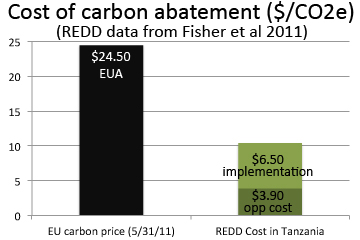REDD should fund efficient stoves, crop yield increases, says study
-----------------
Implementation costs of REDD are higher in Tanzania than commonly acknowledged.
Efforts to reduce greenhouse gas emissions from deforestation and forest degradation (REDD) must incorporate the implementation cost of programs to meet resource demands of local people in order to be successful, argues a new study published in Nature Climate Change.
The research, led by Brendan Fisher of Princeton University, looked at deforestation in the Eastern Arc Mountains of Tanzania. It found that current economic assessments tend to undervalue the cost of meeting expected food and fuel demand by local farmers, who would be expected to curtail forest conversion under the country's REDD program. Failing to meet the needs of local farmers, could either increase poverty or displace forest conversion to forests outside the reach of REDD programs, an issue known as "leakage".
|
Graph (C) by Mongabay |
The authors therefore argue for Smart-REDD, the idea that REDD projects incorporate the implementation cost of implementing programs like boosting agricultural yields to reduce pressure on forest lands and subsidizing efficient cookstoves to cut fuelwood use.
In Tanzania, the researchers estimate the cost of implementing such programs at $6.50 per ton of carbon dioxide emissions avoided (tCO2), well above the $3.90/tCO2 cost of merely compensating for the profits forgone by stopping deforestation.
The authors' conclusions are consistent with other work that has shown implementation and transaction costs can be considerable relative to the opportunity costs of REDD projects, especially those involving small farmers. Opportunity costs are comparatively higher for industrial-scale activities like logging, soy farms, oil palm estates, and rubber and wood-pulp plantations, since these generating more profit per unit of area.
CITATION: Brendan Fisher, Simon L. Lewis, Neil D. Burgess, Rogers E. Malimbwi, Panteleo K. Munishi, Ruth D. Swetnam, R. Kerry Turner, Simon Willcock & Andrew Balmford (2011). Implementation and opportunity costs of reducing deforestation and forest degradation in Tanzania. Nature Climate Change (2011) doi:10.1038/nclimate1119 Published online 29 May 2011
---------------


